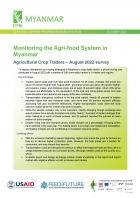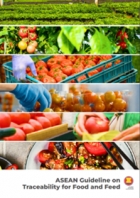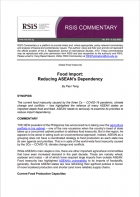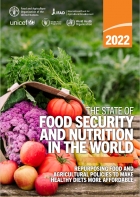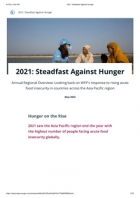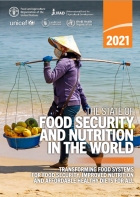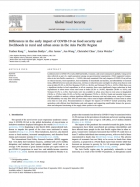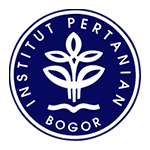Harvested Resources
Monitoring the agri-food system in Myanmar: Agricultural crop traders – August 2022 survey
Crop traders are important actors in the mid-stream of Myanmar’s food supply chains serving as the essential link between farms and food processors, exporters, commodity exchange centers, and urban food markets. Disruptions in the mid-stream brought on by political instability and COVID-19 will likely have an impact on both farmers and urban consumers through market access and crop pricing.This is the eighth Research Note in a series that has monitored the impacts of COVID-19 and political…
31 Oct 2022International Food Policy Research Institute (IFPRI)
Food Security Update
Highlights: The agricultural, cereal, and export price indices were stable over the past 2 weeks, with the agricultural and cereal price indices 1 percent higher than 2 weeks ago. Domestic food price inflation remains high around the world, with high inflation continuing in almost all lowand middle-income countries and the share of high-income countries with high inflation increasing sharply. A recent World Bank blog discussed three policy proposals for making fertilizers more accessible…
11 Aug 2022The World Bank
ASEAN Guideline on Traceability for Food and Feed
ASEAN Secretariat
It is intended that this Guideline serves to establish the requirements for traceability for food and feed in ASEAN and provides the basis for harmonised regulatory requirements and facilitate intraASEAN trade in food products. The establishment of traceability systems across ASEAN Member States will additionally enable the effective deployment of the ASEAN Rapid Alert System for Food and Feed. Traceability is required for the purpose of protecting consumers against food safety hazards…
1 Aug 2022ASEAN Secretariat
Global Food Insecurity – Food Import: Reducing ASEAN’s Dependency
Paul Teng
The current food insecurity caused by the three Cs — COVID-19 pandemic, climate change and conflicts — has highlighted the reliance of many ASEAN states on imported staple food and feed. ASEAN needs to seriously re-examine its priorities to reduce import dependency.
5 Jul 2022S. Rajaratnam School of International Studies, NTU
The State of Food Security and Nutrition in the World 2022
This year’s report should dispel any lingering doubts that the world is moving backwards in its efforts to end hunger, food insecurity and malnutrition in all its forms. We are now only eight years away from 2030, but the distance to reach many of the SDG 2 targets is growing wider each year. There are indeed efforts to make progress towards SDG 2, yet they are proving insufficient in the face of a more challenging and uncertain context. The intensification of the major drivers behind recent…
1 Jul 2022FAO; IFAD; UNICEF; WFP; WHO
2021: Steadfast Against Hunger
Hunger on the Rise 2021 saw the Asia Pacific region end the year with the highest number of people facing acute food insecurity globally. A spiralling combination of conflict, COVID-19 and climate-related shocks drove unprecedented waves of people into food insecurity in many countries. By year-end, 62.2 million people in the region were estimated to be facing acute food insecurity. This is three times higher than pre*-*COVID-19 levels. Just as many countries were recovering from…
7 Jun 2022World Food Programme
Global Report on Food Crises - 2022
The 2022 Global Report on Food Crises (GRFC 2022) highlights the remarkably high severity and numbers of people in Crisis or worse (IPC/CH Phase 3 or above) or equivalent in 53 countries/territories, driven by persistent conflict, pre-existing and COVID-19-related economic shocks, and weather extremes. The number identified in the 2022 edition is the highest in the report’s six-year existence. The report is produced by the Global Network against Food Crises (which includes WFP), an…
4 May 2022World Food Programme
Monitoring the agri-food system in Myanmar: Agricultural crop traders – March 2022 survey
Myanmar Agriculture Policy Support Activity (MAPSA)
Crop traders comprise the mid-stream of Myanmar’s food supply chain and serve as the essential link between farms and food processors, exporters, commodity exchange centers, and urban food markets. Thus, frictions and disruptions in the mid-stream caused by political instability and COVID-19 will likely affect farmers through market access and crop prices and urban consumers through food prices. This Research Note presents results from a telephone survey of 456 crop traders from 122…
12 May 2022International Food Policy Research Institute (IFPRI)
The State of Food Security and Nutrition in the World
FAO, IFAD, UNICEF, WFP and WHO
In recent years, several major drivers have put the world off track to ending world hunger and malnutrition in all its forms by 2030. The challenges have grown with the COVID-19 pandemic and related containment measures. This report presents the first global assessment of food insecurity and malnutrition for 2020 and offers some indication of what hunger might look like by 2030 in a scenario further complicated by the enduring effects of the COVID-19 pandemic. It also includes new estimates of…
FAO
Differences in the Early Impact of COVID-19 on Food Security and Livelihoods in Rural and Urban Areas in the Asia Pacific Region
Yunhee Kang, Anurima Baidya, Alec Aaron, Jun Wang, Christabel Chan, & Erica Wetzler
Highlights Job loss or reduced income due to COVID-19 measures was prevalent among poor populations in the Asia Pacific region. Reducing household food expenditure was more common in urban than rural areas in some countries. Food stock was less available at households in urban than rural areas. Item availability at markets was not severely disrupted in the six countries.
31 Dec 2021Global Food Security Journal
